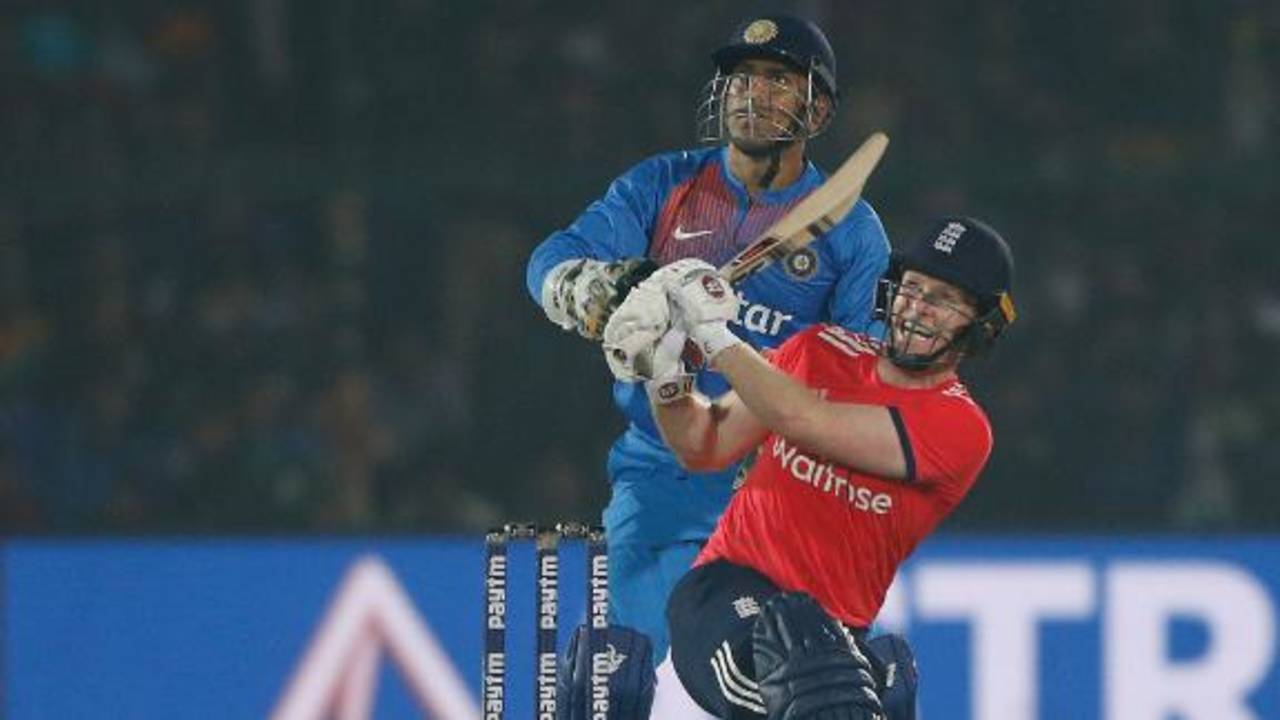How England strangled India
The key the moments of an impressive performance in the field from Eoin Morgan's team which meant India never escaped their clutches
Vishal Dikshit in Kanpur
26-Jan-2017
Jordan changing ends and strategy
Chris Jordan had bowled a no-ball and a wide when he opened the bowling. Perhaps Something didn't feel right. Eoin Morgan switched him to the other end and Jordan changed his field setting to 5-4 by removing the lone slip and bringing three fielders inside the circle on the leg side - short fine leg, midwicket and mid-on - and a square leg in the deep. Once KL Rahul got strike, Jordan brought the field into play by banging in a short ball and the batsman top-edged a pull for a dolly to short fine leg. It was the second time in two innings, after his dismissal in the third ODI, that Rahul skied one while trying to pull a short ball. A few more back-of-length deliveries and a slower one to end the over meant Jordan conceded only three from the over.
Constant bowling changes
Even though Jordan's change of ends worked for England, Morgan made two more bowling changes once Liam Plunkett leaked two fours off Suresh Raina in the sixth over. With the Powerplay done, Stokes was brought on and he bowled varied lines and lengths for two overs to keep the India batsmen guessing. In between, Morgan placed himself at midwicket while introducing Moeen Ali and a whip of wrists from Virat Kohli handed a catch straight to the captain. The constant bowling changes and fall of wickets shifted the momentum towards England as India went without a boundary for 17 balls. Even later, when Plunkett was brought back and dismissed Yuvraj Singh in his third over, Morgan took him off the attack again and returned to Stokes who had seen Raina was shuffling across the stumps way too often and bowled him with a leg-stump yorker. The continuous bowling changes and smart plans meant India never got any big partnership going.
Choking the death-overs specialist
India were desperate for late runs, being only 106 for 5 after 15 overs. Plunkett and Moeen had bowled their quotas and England's pace-bowling options were Stokes, Jordan and Tymal Mills against MS Dhoni. Morgan believed in them - not giving Adil Rashid a single over in the innings - and in the final four overs Jordan and Mills stifled Dhoni cunningly.
In the 17th over, Mills mixed his lengths and brought his pace down from around 145kph to around 105-115kph to get the wicket of Hardik Pandya and keep Dhoni off strike for half the over. Next over, Jordan bowled a flurry of yorkers to Dhoni, who faced four of the six balls but could not score more than four runs off them.
When four balls were left in the penultimate over, Dhoni asked for a different bat, probably a heavier one but left-armer Mills came around the wicket and kept cramping Dhoni for room with the angle and pace - the way Kagiso Rabada had done in late 2015 - and conceded only seven from the over. In the last over, Dhoni creamed two fours off Jordan's slightly inaccurate yorkers but the bowler pulled things back by persisting with his full lengths for the last three balls of the innings. In the end, India managed only 41 runs off the last 30 balls.
Moeen Ali's stifling spell
Moeen had struck with his first ball to claim the big wicket of Kohli. It helped the offspinner in two ways because he was now bowling to two left-handed batsmen - Raina and Yuvraj Singh - who can smash boundaries more easily against spinners who turn the ball into them. Moeen did overpitch a ball to Yuvraj in the 10th over, but once it was dispatched for a cracking four down the ground, he stuck to good-length deliveries, tight lines and did not offer much pace to the batsmen. As a result, he did not concede another boundary. So good were his lines against right-handed batsmen, too, that when Manish Pandey missed an innocuous-looking delivery on off stump, he was pinned lbw and Moeen finished the over with his best T20I figures of 2 for 21. It is not often that Indian batsmen are not able to score freely off a spinner in a T20 on a small ground.
Liam Plunkett's comeback spell
When Plunkett was used to help Jordan switch ends early on, his first two overs saw him leak four fours and his figures read 2-0-22-0. He was taken out of the attack and some would have thought Morgan would try Rashid sooner or later. But Morgan had seen that Plunkett had not bowled all that badly. Three of those four fours were not from the middle of the bat and went to the fence only because Plunkett was bowling in the Powerplay.
"If you watched that first spell, the balls that were hit were a couple of bad balls and there were a couple that actually bounced, the cross-seamers that he bowled," Morgan explained. "That is always an encouraging sign for a tall fast bowler that if he hits the wicket he will get some reward."
Morgan brought Plunkett back at the halfway stage with protection on the leg side. Plunkett banged in a short ball straightaway and struck when Yuvraj tried to swat it to the leg side awkwardly but it only induced a top edge. Plunkett went on to bowl more short-of-length deliveries and didn't offer much room to the middle and lower-order batsmen. He finished his overs by conceding only three runs in the 15th over, setting the tone for the slog overs which went England's way.
Vishal Dikshit is a senior sub-editor at ESPNcricinfo
